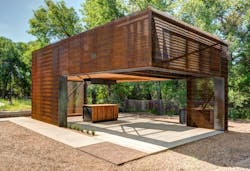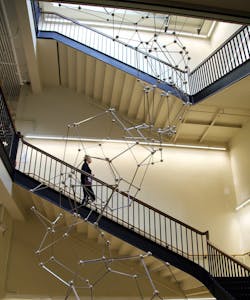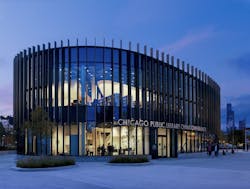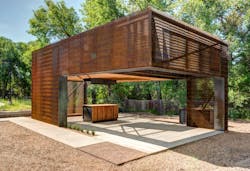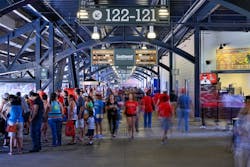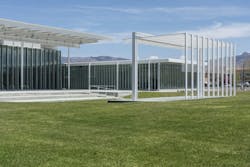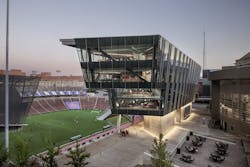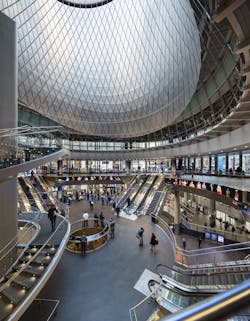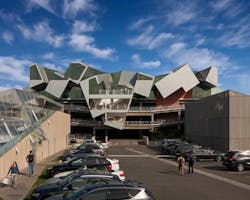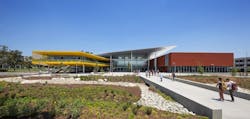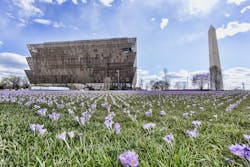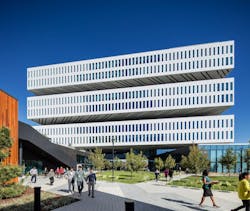Best of structural steel construction: 4WTC, Fulton Center, Pterodactyl win AISC IDEAS2 Awards
By AISC + BD+C Staff
The 2017 IDEAS2 award winners were recently announced at 2017 North American Steel Construction Conference in San Antonio in March. Awards will be presented by AISC to the submitting firms and their fellow project team members at the individual project sites throughout the remainder of the year. Below are the 13 award winners for 2017, separated by their respective categories.
Art Installation/Sculpture/Non-Building Structure
Antony Gormley Sculpture Fabrication & Installation
Cambridge, Mass.
Entering Firm: Summit Metal Fabricators, Plaistow, N.H.
Architect: Antony Gormley Studio, London
Structural Engineer: Robert Silman Associates, Boston
General Contractor: Summit Metal Fabricators, Plaistow, N.H.
Fabricator: Summit Metal Fabricators, Plaistow, N.H. (AISC member / AISC certified fabricator)
Peter Vanderwarker Photographer.
Summit Metal Fabricators (SMF) was contracted by Antony Gormley to fabricate and install his sculpture "CHORD" at a university in Cambridge, Mass. CHORD is a large winding form made of “33 irregular polyhedra” installed in a 12-ft by 12-ft staircase of the mathematics building. The sculpture is 56 feet high, weighs 1,800 lb. and is comprised of 541 stainless steel balls connected by 905 specially formed duplex stainless steel rods. SMF created the sculpture in six sections at their Salem, N.H., shop, and carefully transported the sections to Cambridge and installed them in the staircase.
Merit Award - Less than $15 Million Category
Chinatown Public Library
Chicago, Ill.
Entering Firm: Drucker Zajdel Structural Engineers, Chicago
Architect: Wight & Company, Chicago
Architect: Skidmore, Owings & Merrill LLP, Chicago
Structural Engineer: Drucker Zajdel Structural Engineers, Chicago
Construction Manager: Wight & Company, Chicago
Fabricator: McFarlane Mfg., Sauk City, Wis. (AISC member / AISC certified fabricator)
The project was launched by the Public Building Commission (PBC) of Chicago on behalf of the Chicago Public Library to better forward its mission to Chinatown area patrons. The goal of the project was to provide a library with a modern design that both fits in with and enhances the Chinatown neighborhood. Led by Wight & Company in collaboration with Skidmore, Owings & Merrill (SOM) and Drucker Zajdel Structural Engineers (DZSE), the design‐build team set out to craft a LEED Gold certified building designed for flexibility and utility.
Lamar Station Classroom for Urban Farming
Lakewood, Colo.
Entering Firm: University of Colorado Denver's College of Architecture and Planning. ColoradoBuildingWorkshop, Denver
Architect: ColoradoBuildingWorkshop, Denver
Structural Engineer: Structuralist, Ft. Collins, Colo.
General Contractor: ColoradoBuildingWorkshop, Denver
Jesse Kuroiwa
In the spring of 2014, 16 students worked with Metro West Housing, the City of Lakewood, Colorado’s housing authority, to design and build the Lamar Station Classroom. The classroom’s mission is to educate residents of the nearby transit-oriented development about urban farming, while simultaneously providing space for environmental education and other youth programs. The project brief required the structure to have an opaque wall preserving the privacy of the classroom near the path leading to the light rail line. The client was concerned that the foot traffic would distract residents from learning in the classroom. Coincidentally the brief also asked that the structure maintain a clear sightline from the classroom to their main office located over 300 feet away. The transitional nature of the neighborhood raised concerns about individuals loitering in the classroom when it wasn’t in use. The transparency of the sightline and opacity of the wall were in direct conflict. The student’s response to this dichotomy resulted in the most innovative part of the project.
Merit Award - $15 Million - $75 Million Category
Southwest University Ballpark
El Paso, Texas
Entering Firm: Walter P Moore, Austin, Texas
Architect: Populous, Kansas City, Mo.
Architect: MNK Architects, El Paso, Texas
Structural Engineer: Walter P Moore, Austin, Texas
Structural Engineer: Robert Navarro & Associates Engineering, Inc., El Paso, Texas
General Contractor: Jordan-Hunt, A Texas Joint Venture, El Paso, Texas
Fabricator: W&W AFCO Steel, Oklahoma City, Okla. (AISC member / AISC certified fabricator)
The design for the venue, Southwest University Park, was inspired by architect Daniel Burnham’s most significant work in the American Southwest -- the nearby El Paso Union Depot -- and sought to replicate the classic feel of early twentieth century American “jewel box” ballparks. Structural steel was essential to achieving the project’s design aesthetic, embracing the tight site, and achieving the required delivery speed.
Weber County Library Headquarters Branch
Roy, Utah
Entering Firm: ARW Engineers, Ogden, Utah
Architect: Prescott Muir Architects, Salt Lake City
Structural Engineer: ARW Engineers, Ogden, Utah
General Contractor: R&O Construction, Ogden, Utah
Scott Peterson Studio
The Weber County Library is a new 74,614-sq.-ft facility located in Roy, Utah. The library is located adjacent to the new North Park Elementary School and houses a 255-seat multi-purpose room, children’s, pre-teen and adult services, a smart board room, administrative offices on the second floor, art gallery, outdoor amphitheater and stage, kitchen and café with indoor and outdoor seating areas. The building was constructed to serve as the new library headquarters in the Weber County area which provides access to approximately 330,000 residents and neighbors in surrounding counties. The construction of the new headquarters facility has allowed the original main branch in Ogden to begin seismic renovations needed to meet life safety standards.
Merit Award - Greater than $75 Million Category
Nippert Stadium West Pavilion
Cincinnati, Ohio
Entering Firm: THP Limited Inc., Cincinnati
Architect: Heery Design, Atlanta
Structural Engineer: THP Limited Inc., Cincinnati
General Contractor: Turner Construction Co., Cincinnati
Fabricator: Cives Steel Co., Wolcott, Ind . (AISC member / AISC certified fabricator)
The University of Cincinnati’s Nippert Stadium, originally constructed in 1924, is located in the heart of the urban campus densely surrounded by buildings known for their signature architecture. It is home to the University’s Bearcat football team and left open for the student body to enjoy as a campus green space on nongame days. Having last been updated in 1992, the stadium was in need of a major renovation to increase seating capacity, increase revenue generating spaces, and improve fan amenities. The university developed an ambitious plan for a newly renovated stadium facility and the result is a spectacular new $86 million venue which includes a 115,000-sq.-ft, 130-yards-long West Pavilion with premium seating, luxury suites, press facilities, an iconic footbridge connecting the adjacent Tangeman University Center (TUC) to the West Pavilion, an elevated pedestrian concourse cantilevered from the existing east pavilion seating, and a terrace with below-grade restrooms and concessions.
Fulton Center
New York
Entering Firm: Arup, New York
Architect: Grimshaw Architects, New York
Structural Engineer: Arup, New York
General Contractor: Plaza-Shiavone Joint Venture, New York & New Jersey
Fabricator: STS Steel, Schenectady, N.Y. (AISC member / AISC certified fabricator)
Fulton Center unites six formerly separate subway stations. Originally constructed between 1905 and 1932, these stations were ill-equipped to meet 21st century demands of a transit system serving a metropolitan area of 20 million people. Significantly impacted during 9/11, the subway complex has been the focus of a major government effort to support and aid the redevelopment of this important downtown business community zone. The $1.4 billion center, which includes the new transit center building, renovated historically landmarked Corbin Building, new underground concourse, and numerous access and platform improvements, serves more than 300,000 travelers every day.
National Award - Less than $15 Million Category
Pterodactyl office
Culver City, Calif.
Entering Firm: NAST Enterprises Corp., Los Angeles
Architect: Eric Owen Moss Architects, Culver City, Calif.
Structural Engineer: Nast Enterprises Corp., Los Angeles
General Contractor: Samitaur Constructs, Culver City, Calif.
The “Pterodactyl” is a unique office building which is constructed above an existing four-story steel-frame parking garage structure in Culver City, Calif.; where some of the existing columns are cantilevered beyond the top of the parking building to provide support for the mezzanine and roof superstructure. The outer shell of the building is constructed with metal studs and covered with fire-retardant treaded plywood to achieve the narrowest possible profile and encompassing all structural elements and utilities. The partial mezzanine level is constructed with light-gauge metal deck topped with concrete over steel beams, complementing the orientation of boxes rigorously following an award-winning philosophical architectural theory.
National Award - $15 Million to $75 Million Category
Los Angeles Valley College Monarch Center
Valley Glen, Calif.
Entering Firm: LPA, Inc., Irvine, Calif.
Architect: LPA, Inc., Irvine, Calif.
Structural Engineer: LPA, Inc., Irvine, Calif.
General Contractor: McCarthy Building Companies Inc., Newport Beach, Calif.
Costea Photography, Inc.
The Monarch Center is a U-shaped structure in plan with a cafeteria and dining area located in the center of the facility, a one-story bookstore wing to the east and the elevated “skybox” student union wing to the west. The courtyard enclosed by the U-shaped structure is protected from rain and harsh summer sun by a prominent 20,000-sq.-ft, sloping butterfly-form canopy that towers 41 feet above finished grade at its highest point. A “sustainable mall” with native and drought-tolerant landscape and stormwater management connects the plaza to other campus buildings. The sustainable mall’s stormwater retention and treatment system is fed from the steel-framed butterfly roof and weir and has become a central element of the campus’ identity, winding through and under the student union building’s elevated second floor and opening the central plaza space to the adjacent campus mall. The long-span, cantilevered sloping steel roof is an important part of this sustainable stormwater management system and serves as both a functional and inspirational demonstration of the college’s commitment to holistic sustainable design.
Terminal East Infill at Austin-Bergstrom International Airport
Austin, Texas
Entering Firm: Architectural Engineers Collaborative, Austin, Texas
Architect: Page/, Austin, Texas
Structural Engineer: Architectural Engineers Collaborative, Austin, Texas
General Contractor: Hensel Phelps, Austin, Texas
Fabricator: Hirschfeld Industries, San Angelo, Texas (AISC member / AISC certified fabricator)
In recent years, Austin, Texas, has grown from a sleepy college town to an international hub of live music, food, art, business, and technology. Austin‐Bergstrom International Airport (ABIA) opened in 1999; for much of its life, the airport has seen nearly uninterrupted passenger growth. In anticipation of continued growth, a 55,000‐sq.-ft expansion to ABIA’s terminal was planned. The $62 million project also includes renovation of 17,000 square feet of existing space. Design of the project, known as the Terminal East Infill (TEI), began in January 2013 and construction was completed in mid-2015. The design-build team was tasked with developing a space that honored the vocabulary of the existing terminal building while adopting a fresh and bold new aesthetic.
National Award - Greater than $75 Million Category
National Museum of African American History and Culture
Washington, D.C.
Entering Firm: Clark/Smoot/Russell A Joint Venture, Bethesda, Md.
Architect: Adjaye Associates, London
Architect: SmithGroupJJR, Washington, D.C.
Architect: Perkins + Will, Durham, N.C.
Structural Engineer: Silman, New York
Structural Engineer: Guy Nordenson and Associates, New York
General Contractor: Clark/Smoot/Russell A Joint Venture, Bethesda, Md.
Located on the National Mall in the shadow of the Washington Monument, the look of the National Museum of African American History and Culture (NMAAHC) is unique, featuring a inverse truncated pyramid, known as the corona, covered by bronze coated panels and supported by a network of steel trusses. The Clark/Smoot/Russell team will construct the 400,000 square-foot museum in time to open to the public in September 24th, 2016.
Samsung Americas Headquarters (Device Solutions)
San Jose, Calif.
Entering Firm: Arup, Los Angeles
Architect: NBBJ, Los Angeles
Structural Engineer: Arup, Los Angeles
General Contractor: Webcor, San Francisco
Fabricator: Gayle Manufacturing, Woodland, Calif. (AISC member / AISC certified fabricator)
Samsung’s Device Solutions group aspired to build a collaborative, flexible and sustainable environment that reflected their corporate mission and profile, and helped them to recruit top candidates. Their ambition was to create a collaborative campus, engaging the public and encouraging their staff to reach their full potential. NBBJ and Arup collaborated to develop and iterate innovative design schemes. The resulting courtyard tower, surrounded by gardens, a data center, parking structure, and café, engages employees and pedestrians as a new icon for San Jose. Balance and integration of indoor and outdoor office spaces drove the architectural and structural design. The 10-story tower is organized around a central courtyard. With no perimeter columns on the east and west sides, the tower appears to float at every third level and offers occupants clear external views. The resulting spaces, and the atriums around them, are dedicated for collaboration areas, facilitating casual meetings and breaks from the traditional work spaces.
Presidential Award of Excellence in Engineering
Four World Trade Center
New York
Entering Firm: Leslie E. Robertson Associates, New York
Owner: Silverstein Properties, New York
Architect: Maki & Associates, Tokyo
Architect: Adamson Associates, New York
Structural Engineer: Leslie E. Robertson Associates, New York
General Contractor: Tishman Construction Corp., New York
Fadi Asmar
The World Trade Center site is hallowed ground. Its redevelopment poses the challenge of not only redefining the iconic Manhattan skyline, but also influencing the greater cultural fabric of American society. As an office tower, 4 World Trade Center (4WTC) serves as a beacon for businesses returning to downtown Manhattan -- 250,000 daily commuters pass through the lower levels on their way to one of 13 subway or commuter rail lines that surround the tower. More importantly, the structure pays respect to the tragic history of the grounds commemorated by the National September 11 Memorial. Twelve years removed from the devastating attacks of September 11, 2001, the 72-story, 2.3 million-sq.-ft 4WTC became the first tower to open on the original 16-acre site. The goal of the tower’s design was two-fold: to construct a powerful and efficient structure that would emanate a quietly dignified presence, and to enrich and enliven the surrounding urban environment. 4WTC meets these demands through significant yet restrained structural innovation.
